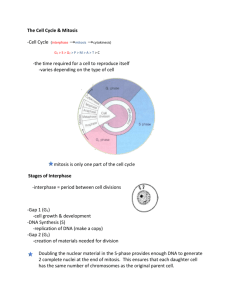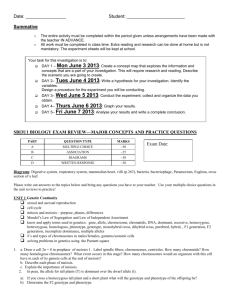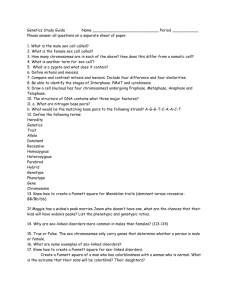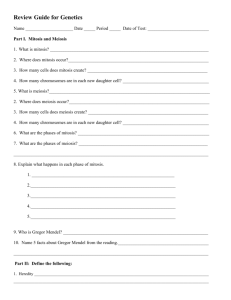plants chromosomal
advertisement
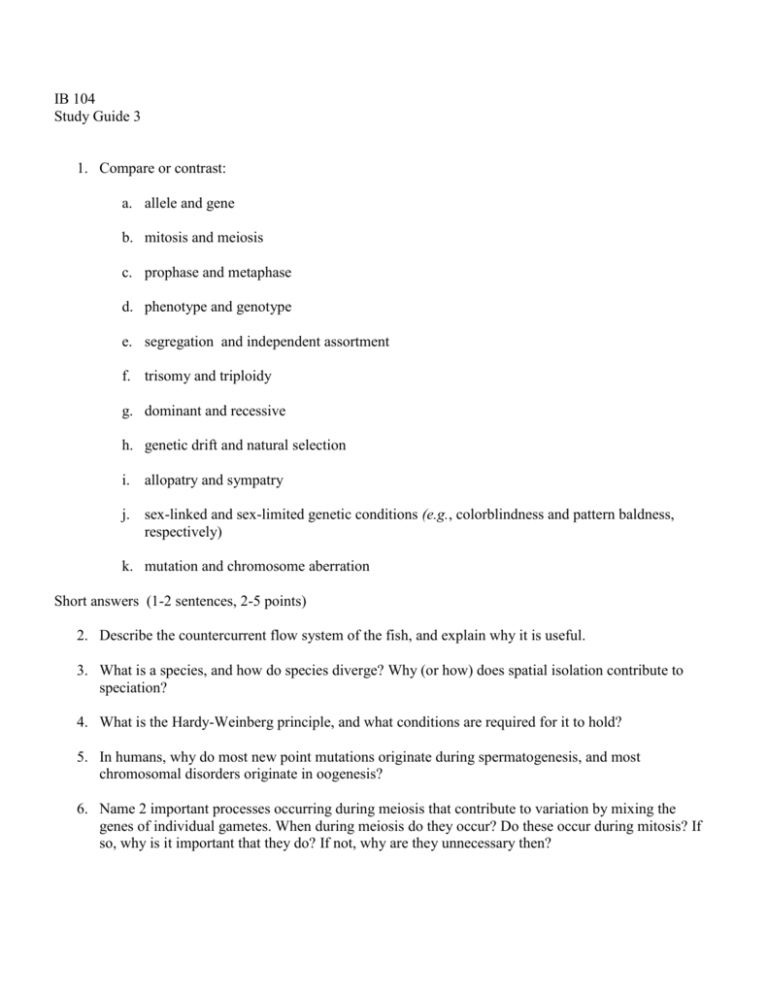
IB 104 Study Guide 3 1. Compare or contrast: a. allele and gene b. mitosis and meiosis c. prophase and metaphase d. phenotype and genotype e. segregation and independent assortment f. trisomy and triploidy g. dominant and recessive h. genetic drift and natural selection i. allopatry and sympatry j. sex-linked and sex-limited genetic conditions (e.g., colorblindness and pattern baldness, respectively) k. mutation and chromosome aberration Short answers (1-2 sentences, 2-5 points) 2. Describe the countercurrent flow system of the fish, and explain why it is useful. 3. What is a species, and how do species diverge? Why (or how) does spatial isolation contribute to speciation? 4. What is the Hardy-Weinberg principle, and what conditions are required for it to hold? 5. In humans, why do most new point mutations originate during spermatogenesis, and most chromosomal disorders originate in oogenesis? 6. Name 2 important processes occurring during meiosis that contribute to variation by mixing the genes of individual gametes. When during meiosis do they occur? Do these occur during mitosis? If so, why is it important that they do? If not, why are they unnecessary then? Genetics Problems: 7. Any genetics problem similar to those in the lab manual or to the examples given in lecture. If I ask you to find the genotype of the progeny, I will specify the type of inheritance (dominant, sex-linked, etc) but I may also ask you to figure out the mode of inheritance from the data given. 8. (10 points) In mice, black coat color is dominant to brown. What would the F1 offspring of a cross between a homozygous brown female and a homozygous black male look like? What would the F2 offspring look like? 9. (10 points) In peas, purple flower color is dominant to white, and tall plant size is dominant to short. Two tall, purple pea plants are crossed. The offspring consist of 25 white flowered tall plants and 75 purple-flowered tall plants. What are the most likely genotypes of the parents? 10. (5 points) In poultry, rose comb is dominant over single comb. A farmer thinks that some of his rosecomb hens are offspring of a single-comb white Leghorn rooster and a rose-comb Wyandotte hen. Show a cross he could make to find out which hens are such hybrids. 11. The following diagrams show 6 stages of cell division in a diploid organism with 4 chromosomes (n = 2). Name 5 of the stages. 12. (10 points) The American Badger has 32 chromosomes in its skin cells. a. What is the diploid number of chromosomes for this organism? ________ b. How many chromosomes would its sperm have? ________ c. Assuming that N represents the haploid amount of DNA, how much DNA is present in a badger’s cell i. at prophase of mitosis ________ ii. at metaphase of mitosis ________ iii. at prophase 1 of meiosis in its sperm ________ iv. at the completion of meiosis in its eggs _______ 13. List order in which the following appear in the evolutionary history of Homo sapiens. List only those groups that are in the direct ancestral line. prosimians New World monkeys Old World apes therapsids chimpanzees Slow loris Australopicethenes Homo neanderthalis marsupials 14. Essay Questions: I will give these 3 questions on the exam, and you will have to answer one of them. Therefore, you can prepare your answer ahead of time (and I expect the quality of the answer to reflect this preparation.) a. What do you think Michael Pollan means when he says “Eat food. Not too much. Mostly from plants.”? Do you agree? Why or why not? b. What is the current view of how evolution occurs? c. Why does natural selection work very slowly (poorly?) to eliminate recessive alleles from the population?







